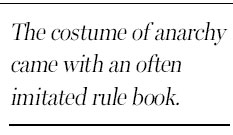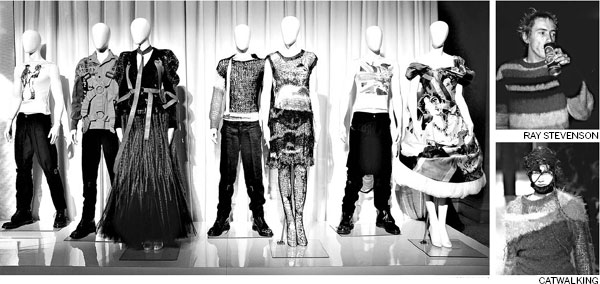Punk's anti-style culminates in haute couture
Updated: 2013-05-05 07:37
(The New York Times)
|
|||||||
|
Examples of punk's fashion legacy will go on display at New York's Metropolitan Museum. Johnny Rotten, top right, in 1976; a Junya Watanabe line. Joe Schildhorn / Bfanyc.com |
Everyone loves a uniform. In both the mainstream and the counterculture, they connote order and authority. They shape the story. They make things easy. For the wearer, they stand in for having to speak. For the observer, they serve as shorthand.
They are also constraints, of course.
Punk, in its original incarnation, in England in the 1970s, was intended to be an angry rejoinder to all that. Skinheads, teddy boys, mods, rockers: they all had a comprehensible, consistent look. Punks scrambled it all, cutting it to pieces and stitching it together in new ways. It was a raised middle finger to the long legacy of the uniform - except for the fact, of course, that it was one itself.
The uniform of no uniform became punk's loudest and most lasting aesthetic legacy, probably to its detriment. It was an easy caricature, a readily reproducible expression of working-class angst.
"Punk: Chaos to Couture," the exhibition at the Metropolitan Museum of Art in New York on view starting May 9, connects the dots between punk's anti-formal innovations and high fashion's borrowings - or outright copyings - of them.

But the title is a bit misleading. Certainly decay and disorder were central to punk's ideology, but the chaos was always controlled, and the chaos was always couture. Punk may have been a deconstruction, but it wasn't an accident.
Juxtaposing the old garments with the tributes, as the exhibition does, paints the punk items as found gems rescued and resuscitated by keen-eyed designers with traditional skill sets - an eruption of happenstance into the mainstream. But punk's own rule book - its costume of anarchy - was plenty powerful before anyone was looking. The desecration of logos and images, the deliberately shoddy construction, the mixing of references, the emphasis on hard as well as soft - these were key tenets of the style that demanded adherence. They were styles to wear, and also models for living.
And these visions moved fast, creating looks that settled in at different intensity levels on either side of the Atlantic. In New York, the dominant models were the morose, dry-wit sartorialism of Richard Hell, who famously stenciled the phrase "please kill me" on a T-shirt, or the burnout chic of the Ramones, with their black leather jackets and airtight ripped jeans. Understated and tattered, they were surprisingly elegant, communicating a lot with only a few gestures.
Punk as spectacular expression took hold more in England, largely in the hands of the Sex Pistols' impresario Malcolm McLaren and the radical designer Vivienne Westwood at their influential King's Road shop called at one point Sex, and later, Seditionaries, among other names. Together, they took some of the shrugs of the New York style and blew them up, giving them a neon attitude.
Suddenly, punk became a set of incendiaries designed for maximum provocation. The T-shirts, mostly tame by modern standards, were angry and whimsical, full of assaults on various logos and images: the Queen of England, naked cowboys, Jesus, swastikas and iron crosses, Snow White. There were detours through bondage gear and schoolboy outfits. McLaren and Ms. Westwood showed that all of history was up for grabs for reinterpretation.
But legibility and consistency were key to that proposition. Because of that, punk was easily brandable and commodified - divorced from its original ideology, sure, but reproducible forever.

Almost four decades on, punk has evolved - as a word, as a genre, as a style. In fashion, it's just another reference to pull from, as valid in its negation of structure as anything that relies on structure. Modern punk, in so much as such a thing still exists, has been ossified in tight T-shirts and shellacked hair; it owes only a little to its forebears.
Still, the genre stands alone in the depth of its influence on high fashion. Hip-hop has left a mark, too, though it has been spotty and faint. Grunge has had its moments over the years, including recently, but was less a worldview than a cloak. If any musical movement has the potential to sustain an exhibition like the one at the Met a few decades down the line, it's probably rave culture and its many tributaries, which have ideas about silhouette, about structure, about size, about color that are both sui generis and viral.
Rave knows what punk knew: the clothes were always meant to be shown off. That the clothes might be someday enshrined - entombed? - in the same museum that also houses towering collections of Renaissance art, Egyptian artifacts and more is perhaps the end logic of Mr. Hell's nihilistic ideology, the dream of McLaren's hucksterism.
Such an exhibition wouldn't be possible without the systemic dismantling of the walls around high and low culture that punk helped kick down even harder than its predecessors, to say nothing of the cultural tourism that it inevitably leads to. Screaming as loud as the intended targets and getting heard - well, that was part of the goal the whole time.
At minimum, it makes for a rich renewal of debate: Does infiltration corrupt, or do the corrupt infiltrate?
The New York Times
(China Daily 05/05/2013 page12)
